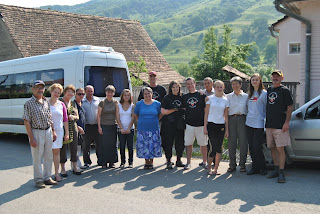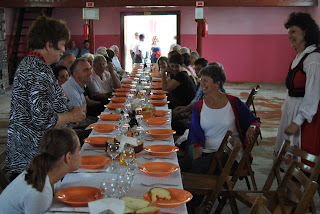In the morning (Saturday), John, Jo Anne, and Denisa's hosts (the Nagy's) also baked bread. With the last of the dough they made a pastry called kertesz kolacs (chimney cakes). They rolled a ribbon of dough onto a wooden form like a long rolling pin. Then they basted it with oil and egg, and rolled it in sugar. When the embers were piled on the platform in front of the bread oven, they lay the rod across the embers, supported on bricks, and rolled it as it cooked, so that it would caramelize evenly. When they were done, they would carefully slip the pastry off the pins. They were delicious, and they made enough of them to feed an army.

We also met Eva and Csilla, the daughters of the Nagy's, who stopped to say hi. Eva just finished university and is starting graduate school in special education. Csilla is about to start university in the fall and wants to be a lawyer. Csilla has also been Jo Anne's pen-pal for the past year (we're not sure at what point she realized that she was not corresponding with a fellow teenager).

The day before, Mary met some little boys getting water from the well outside her guest house. This morning she discovered fresh flowers on her doorstep, which the boys were embarrass to admit was their handiwork.
Saturday's theme was time travel. We visiting several local workshops, including a blacksmith, a wheelwright, and an embroiderer. All three are masters of dying crafts with nobody to carry on their tradition. The blacksmith made two horseshoes (his primary product) while we were there and his assistant was Lajos, who made and cooked yesterday's mittitei. The blacksmith has been doing this work for 57 years, since he was 14. The wheelwright demonstrated several special tools he uses. In addition to wheels, he also makes barrels for storing the fruit waiting to be distilled into palinka. The embroiderer (Lajos's mother Matild) invited us into her home, which was filled with gorgeous examples of her work.



The highlight of the afternoon was a horse cart ride through the village and up into the hills. We met our friend the stork again and headed out of town. The lay president of the church, Mihai, whom you have seen in a previous post milking his cows, became a grandfather yesterday. We think the stork is resting by the church from his labors. (They have the same folk belief about storks and babies that we do.)
The ride was very bumpy but scenic, as we passed families we met at the party yesterday working in the fields. Most agriculture in Gagy is still horse-powered and you still see horse carts on the highway carrying hay or logs (to the vexation of all the truck drivers). We passed a renovated cabin in the hills that is now used as a summer camp for children. The view from the top was breathtaking. And on the way down, we saw a nice scene that sums up the local culture: our friend Lajos, one of the horse cart drivers, on his cell phone.

























































